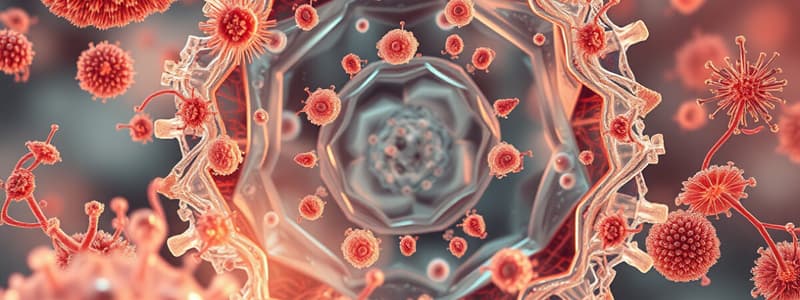Podcast
Questions and Answers
What is the primary function of nerve cells (neurons)?
What is the primary function of nerve cells (neurons)?
- Form protective layers and barriers.
- Facilitate movement through contraction.
- Carry oxygen throughout the body.
- Transmit electrical impulses throughout the nervous system. (correct)
Which type of muscle cell is striated and under involuntary control?
Which type of muscle cell is striated and under involuntary control?
- Skeletal Muscle Cells
- Epithelial Cells
- Cardiac Muscle Cells (correct)
- Smooth Muscle Cells
What is the role of the acrosome in sperm cells?
What is the role of the acrosome in sperm cells?
- To contain chlorophyll for photosynthesis.
- To store nutrients for energy.
- To propel the sperm forward.
- To contain enzymes to penetrate the egg. (correct)
Which type of epithelial cell is characterized by a cube-like shape?
Which type of epithelial cell is characterized by a cube-like shape?
What type of blood cell is primarily responsible for the immune response?
What type of blood cell is primarily responsible for the immune response?
Which structure in plant cells is responsible for performing photosynthesis?
Which structure in plant cells is responsible for performing photosynthesis?
What is the main function of smooth muscle cells?
What is the main function of smooth muscle cells?
What characteristic feature distinguishes cardiac muscle cells from skeletal muscle cells?
What characteristic feature distinguishes cardiac muscle cells from skeletal muscle cells?
Which of the following characteristics is exclusive to eukaryotic cells?
Which of the following characteristics is exclusive to eukaryotic cells?
What is a unique feature of plant cells compared to animal cells?
What is a unique feature of plant cells compared to animal cells?
Which organelle is primarily responsible for energy production in animal cells?
Which organelle is primarily responsible for energy production in animal cells?
Which type of cell features a large central vacuole?
Which type of cell features a large central vacuole?
What distinguishes fungal cells from plant cells?
What distinguishes fungal cells from plant cells?
Which of the following cell types contains organelles such as endoplasmic reticulum and Golgi apparatus?
Which of the following cell types contains organelles such as endoplasmic reticulum and Golgi apparatus?
Which of the following examples depicts a characteristic of unicellular organisms?
Which of the following examples depicts a characteristic of unicellular organisms?
What is a common feature of both prokaryotic and eukaryotic cells?
What is a common feature of both prokaryotic and eukaryotic cells?
Flashcards are hidden until you start studying
Study Notes
Prokaryotic Cells
- Lack a nucleus and membrane-bound organelles.
- Examples include Bacteria and Archaea.
- DNA is found in a nucleoid region within the cell.
- Simple structure features a plasma membrane, cell wall, and may have flagella or pili.
- Generally smaller than eukaryotic cells.
Eukaryotic Cells
- Contain a nucleus and membrane-bound organelles.
- Examples include Animal cells, Plant cells, Fungal cells, and Protist cells.
- DNA is contained within the nucleus.
- Complex structure includes organelles such as mitochondria, endoplasmic reticulum, and Golgi apparatus.
Specific Cell Types
Animal Cells
- Lack a cell wall, have irregular shapes, and often contain lysosomes and centrioles.
- Key organelles include:
- Nucleus for storing genetic information.
- Mitochondria for ATP production.
- Endoplasmic Reticulum (ER) for protein (rough ER) and lipid (smooth ER) synthesis.
- Golgi Apparatus for modulating, sorting, and packaging proteins and lipids.
- Lysosomes for digesting macromolecules and cellular debris.
Plant Cells
- Characterized by a rigid cell wall, chloroplasts, and a large central vacuole.
- Key organelles include:
- Chloroplasts as the site for photosynthesis.
- Cell Wall for structural support and protection.
- Large Central Vacuole for maintaining turgor pressure and storing nutrients and waste products.
Fungal Cells
- Similar to plant cells but have a cell wall made of chitin instead of cellulose.
- Key organelles include:
- Nucleus for housing genetic material.
- Vacuoles for storing nutrients and waste.
- Cell Wall composed of chitin.
Protist Cells
- A diverse group exhibiting characteristics of animal, plant, or fungal cells.
- Notable examples:
- Amoebas: Unicellular and move using pseudopodia.
- Paramecia: Unicellular and move using cilia.
- Algae: Photosynthetic organisms with chloroplasts.
Specialized Cell Types
- Specialized cells have unique structures and functions to perform specific roles within an organism, differing morphologically and biochemically from non-specialized cells.
Examples of Specialized Cells
-
Nerve Cells (Neurons)
- Function: Transmit electrical impulses throughout the nervous system.
- Structure includes axons (carry signals away), dendrites (receive signals), and synaptic terminals (release neurotransmitters).
-
Muscle Cells
- Function: Facilitate movement through contraction.
- Types include:
- Skeletal Muscle Cells: Striated, voluntary, attached to bones.
- Cardiac Muscle Cells: Striated, involuntary, found in the heart.
- Smooth Muscle Cells: Non-striated, involuntary, located in internal organ walls.
-
Blood Cells
- Types:
- Red Blood Cells (Erythrocytes) for carrying oxygen.
- White Blood Cells (Leukocytes) for immune responses.
- Platelets (Thrombocytes) for blood clotting.
- Types:
-
Epithelial Cells
- Function: Form protective layers and barriers on surfaces and organs.
- Types include:
- Squamous Epithelium: Thin, flat cells for skin and blood vessels.
- Cuboidal Epithelium: Cube-shaped cells for ducts and glands.
- Columnar Epithelium: Tall cells in the digestive tract for absorption and secretion.
-
Sperm Cells
- Function: Fertilize egg cells during reproduction.
- Structure includes:
- Flagellum: Tail-like propelling structure.
- Acrosome: Cap-like structure with enzymes to penetrate the egg.
-
Plant Cells
- Function: Perform photosynthesis and provide structural support.
- Specialized structures include:
- Chloroplasts for capturing light energy.
- Rigid Cell Wall for strength.
- Central Vacuole for maintaining turgor pressure and nutrient storage.
Studying That Suits You
Use AI to generate personalized quizzes and flashcards to suit your learning preferences.




